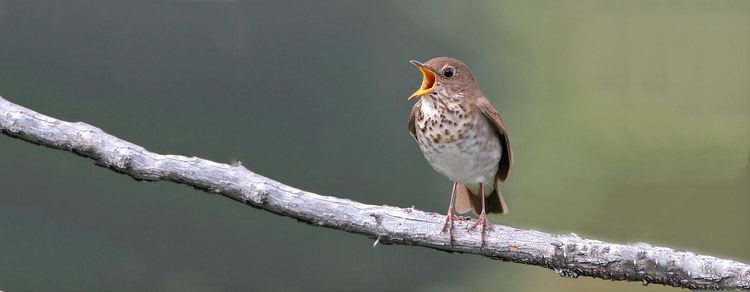Kingdom Animalia Order Passeriformes Genus Catharus Higher classification Catharus | Phylum Chordata Family Turdidae Scientific name Catharus bicknelli Rank Species | |
 | ||
Similar Bird, Catharus, Thrush, Grey‑cheeked thrush, Veery | ||
Bicknell s thrush song
The Bicknell's thrush (Catharus bicknelli) is a medium-sized thrush, at 17.5 cm (6.9 in) and 28 g (0.99 oz). It was named after Eugene Bicknell, an American amateur ornithologist, who discovered the species on Slide Mountain in the Catskills in the late 19th century.
Contents
- Bicknell s thrush song
- Bicknell s thrush feeding nestlings
- Description
- Habitat and range
- Breeding
- Food and feeding
- Conservation and threats
- References
Bicknell s thrush feeding nestlings
Description
Bicknell's thrush is just slightly smaller than the other northern migratory Catharus thrushes, with an average length of approximately 17 cm (6.7 in) and a mean weight of 27.8 g (0.98 oz), with a range from 21 to 36.8 g (0.74 to 1.30 oz). The sexes are roughly the same size, although males average slightly larger in wing length. Adults are olive-brown on the upperparts, slightly redder on the tail. The underparts are white with gray on the flanks; the breast is greyish brown with dark spots. They have pink legs, a faint grey eye ring, and gray cheeks. They average slightly smaller than the very similar gray-cheeked thrush but are all but indistinguishable in outward appearance. Together, gray-cheeked and Bicknell's thrush form a cryptic species pair, and were indeed formerly considered conspecific. The song is a jumbled series of flute-like tones ending on a higher note.
Habitat and range
Their breeding habitat is the coniferous forests in southeastern Quebec to Nova Scotia and the sky islands of northern New England and New York state. It is the rarest and most secretive of the breeding thrushes in North America and it is the only bird species whose breeding range is entirely restricted to the northeastern part of the continent. They usually breed at higher elevations, normally nesting above 915 m (3,002 ft).
These birds migrate to the West Indies and the Greater Antilles, with an estimated 90% of the individuals wintering on Hispaniola. Bicknell's and gray-cheeked thrush, along with the veery, make up a close-knit group of migrant species.
Breeding
Bicknell's thrushes have an unusual mating system in which females mate with more than one male. Such a practice, known as polygynandry, is not known to occur in other thrushes. As many as four males perform duties connected with one nest, including bringing food for the nestlings. The nest itself is typically a bulky cup, close to the trunk of a conifer. Nestlings grow rapidly, developing in 12 days from peanut-sized hatchlings to completely feathered adult-sized birds. Ticks, blowflies, and lice are some of the parasites with which Bicknell's thrush must contend. The red squirrel is the main predator of eggs and nestlings, according to breeding ecology studies. Predators confirmed to hunt nesting adults have consisted of the sharp-shinned hawk, the long-tailed weasel, and the northern saw-whet owl. On the nesting grounds there are at least six other predators suspected or likely to depredate nests and at least three other predators that may attacks nesting adults, to say nothing of potential predators during migration or on wintering grounds.
Food and feeding
The thrush's diet consist mainly of insects, but wild fruits are added in late summer, during migration, and on the wintering grounds. They usually forage on the forest floor, but also catch flies, and glean insects from the foliage of trees.
Conservation and threats
Its numbers are declining in some parts of its already limited range as a result of habitat degradation. Scientists believe that industrial pollution is one of the main reasons for the decline of the red spruce, an important element in Bicknell's thrush habitat in the United States. Airborne heavy metals may also damage high-elevation forests in the northeastern United States. Furthermore, based on expected substantial carbon dioxide increases by the end of the century, scientists predict a radical reduction of balsam fir forest in the eastern United States. If average global temperatures increase and forests change as much as predicted, Bicknell's thrush habitat is very likely to be altered in ways that may seriously affect the species' survival.
Industrial forestry practices, although possibly harmful, may be modified to aid in conservation efforts to protect Bicknell's thrush. While more study is needed, the bird's apparent acceptance of certain commercial second-growth forest gives promise to possibilities of man-made "growing" Bicknell's thrush habitats in the future.
There is also considerable concern about the degradation of Bicknell's thrush's wintering habitats. The Dominican Republic's native forests are under considerable pressure from naturally occurring events such as hurricanes, as well as changes from agricultural activities, particularly at low altitudes. The forested lands of Haiti have been almost completely eliminated, and in Cuba, most of the known suitable habitat exists only in protected parklands.
